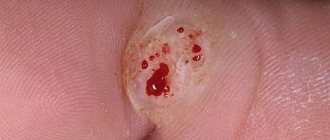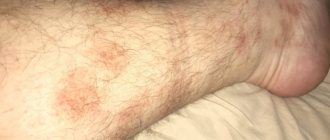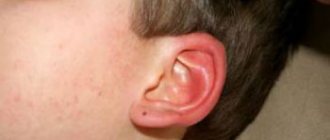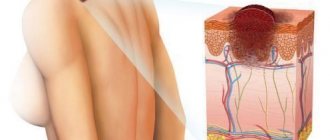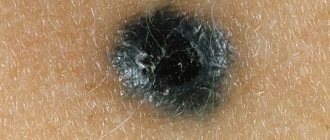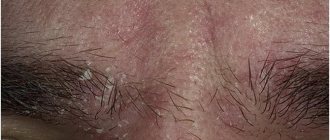Herpes is a common chronic disease. The causative agent of herpes infects 90% of the world's population. The infection is provoked by viruses, worsens when the immune system is weakened, and affects different people, regardless of age and gender. Typically, herpes is a specific skin rash on the lips, less often on the genitals. Does herpes occur on the feet? It happens, but this form of pathology is rare and is not the norm. Non-standard forms of infection, including herpes on the leg, more often cause severe complications that are dangerous not only to health, but also to life.
Causes of rashes on legs
Herpes on the legs occurs as a result of infection with specific viruses. There are 8 such viruses, and rashes on the legs can be caused by the first three:
- 1 and 2 – viruses of a simple type, the first causes labial herpes (on the lips), the second – genital;
- 3 – Varicella-zoster virus, a provocateur of chickenpox and herpes zoster (a rare recurrence of chickenpox).
These are the main causes of herpes on the leg. Almost every person has herpes viruses in the body, but only 20% of those infected experience exacerbations of the infection. The reason is the ability of our immunity to contain the activity of viruses. Symptoms of a herpes infection on the legs and other parts of the body will not appear until the immune system is weakened. This may happen due to:
- stress;
- hypothermia;
- chronic infections;
- hidden infections that provoke immunodeficiency (HIV, hepatitis);
- taking medications that weaken the immune system;
- old age;
- bad habits.
A weakening of the immune system sufficient to activate infection must be provoked by several factors simultaneously. Viruses are transmitted from a sick person to a healthy person in all known ways: airborne droplets, sexual contact, household contact, so it is impossible to avoid infection. Once the virus enters the body, it will remain there forever. After the first outbreak of infection, the immune system will develop antibodies against the virus, which will weaken it, but not completely destroy it. The weakened virus will settle in the nerve cells of the body and “fall asleep” until the next decrease in immunity.
Herpes simplex viruses 1 and 2 recur regularly – 4-6 times a year. The Varicella-zoster virus, which causes chickenpox, appears in most people only once in their lives. It is extremely rare that chickenpox gives a one-time relapse in the form of herpes zoster in children, men and women. Herpes zoster usually occurs in elderly and severely weakened people (for example, patients with cancer, HIV infection, AIDS).
Prevention
Simple rules will help prevent the development of exacerbation:
- Compliance with the principles of proper nutrition.
- Rejection of bad habits.
- Moderate physical activity.
- Washing hands after visiting public places.
- Strengthening the immune system: hardening, walking barefoot on grass and small pebbles in the summer, taking vitamins and mineral complexes in the winter.
- Timely treatment of chronic diseases.
- Regular medical examination and medical examination.
If the disease is detected in time and treated correctly, the risk of exacerbation in the future is reduced, the pathological process passes without complications and severe discomfort.
What does herpes on the leg look like?
Symptoms depend on the type of infection. Herpes simplex (types 1, 2) manifests itself as a small rash in the form of blisters located next to each other in the form of a small island. The size of the infectious focus is minimal; it can be covered with the palm of your hand.
The rash is pinkish, inflamed, itchy, with transparent sticky contents inside.
When the integrity of the rash is damaged, the inflammation intensifies and is accompanied by burning and pain. A simple herpetic infection is most often localized on the inner thigh or lower leg, and can be on both legs at the same time. Herpes on the thigh during relapses occurs in the same place.
With the genital type of pathology, the first rashes appear on the intimate organs, and relapses can spread to the thighs. The rash can appear on any part of the leg and even on the knee. Herpes is rarely seen on the feet and between the toes. Herpes on the toes usually causes a rash on only one toe - the big toe. In addition to the rash, a person feels a slight malaise and a slight increase in temperature (up to 37-38°). These symptoms resemble the onset of a cold. Possible additional signs:
- nausea;
- headache;
- pain in the joints of the legs;
- insomnia, drowsiness;
- irritability.
Shingles has its own characteristics of localization on the body. It is observed only on one leg and is a long strip of rash in the form of small blisters. The rash is bright red, very itchy, scalding, and painful. Before and after the onset of the main symptoms of infection, aching pain may be observed in the affected area (often in the area of a large nerve) that does not go away for weeks or even months. The shingles rash usually starts on the patient's side and then moves to the outside of the thigh. Additional symptoms are the same as for herpes simplex.
Symptoms of herpes sciatic nerve
With herpes of the spinal nerves, the rashes characteristic of the virus (small painful watery pimples on the lower back, shoulder blades and along the spine) do not always appear, so it is often confused with degenerative-dystrophic changes in the spine. At first glance, its symptoms do not differ from inflammation of the trigeminal nerve after hypothermia or pinching. First, the virus produces weakness, aching pain in the lower back, and then a sharp piercing paroxysmal pain in the sacrum and lower back, radiating to the buttocks and legs (usually the left).
This is interesting: Herpes on the body - what kind of disease is it? All information about herpes
The fact that it was herpes that put you to bed can be understood by an increase in body temperature (37-39 degrees), severe weakness and body aches, increased or delayed urination, constipation and impaired potency. In addition, sensitivity in the skin in the lumbar region may increase significantly. If the pain is still accompanied by painful rashes or the appearance of red spots, rest assured, it is herpes.
Clinical picture of the disease
Herpes on the foot and other parts of the leg occurs in stages:
- The affected area of the skin begins to hurt, swell, become inflamed, and redness appears even before the rash. Symptoms are often observed in only one leg.
- The next day, characteristic herpetic rashes appear.
- After 2-3 days, the herpes blisters on the leg mature, burst, and in their place ulcers form, which quickly become crusted.
- After another 4-5 days, the crusts fall off and the symptoms disappear without a trace. In the case of herpes zoster, the period of active symptoms is prolonged, and after it there is a long-term neuralgic pain.
This is what the standard clinical picture of a viral infectious disease on the legs looks like. In addition to the standard form, herpes can be generalized - distributed throughout the body. A generalized infection affects not only the skin and mucous membranes, but also the surfaces of internal organs, as well as joints. All this causes severe symptoms associated with disruption of the affected organs and joints.
How dangerous is it that your feet are affected by a herpetic infection?
Herpes of the feet cannot particularly harm the health of an adult with a functioning immune system. With timely correct treatment under the supervision of a doctor, recovery occurs quickly.
In advanced situations, the risk of developing severe complications increases. The virus injures cells in the brain and spinal cord and impairs the functioning of the central nervous and respiratory systems. Complications are:
- trigeminal nerve palsy;
- paraplegia;
- failure of organs and body systems affected by infection;
- even death (extremely rare and only in people with severe immunodeficiency, infected with HIV and patients with AIDS).
The spread of infection to the eyes can lead to glaucoma and blindness. An infection in a woman during pregnancy, especially in the first trimester, can cause miscarriage or birth defects in the child.
How to distinguish it from other diseases
Herpes infection on the feet is similar to other skin diseases. Skin lesions of a different nature can be distinguished from herpetic ones by symptoms:
- the allergy resembles a viral rash, but allergic blisters do not burst and do not form ulcers, they pop up only after contact with a certain irritant (wool, cold water, pollen);
- fungal infections are similar to herpes, but are observed mainly on the nails and only sometimes affect the skin; There are no blisters with fungus.
A viral rash is present on the skin for 1-2 weeks, and then disappears even without treatment. If the rash on the legs is present for more than 2 weeks, then it is not a virus, but eczema or another disease.
Symptoms of the disease
Herpes can affect the entire leg. Its symptoms spread to the lymph nodes and joints. External manifestations on the epithelium can come quite soon. The rash begins to heal and the skin stops itching 2 weeks after the first manifestations. When the active phase ends, areas appear on the epithelium that are slightly different in color from the rest of the body. This phenomenon is temporary and does not pose any danger.
With herpes, the patient almost always, in addition to symptoms on the skin, also has internal manifestations that may not be directly related to pain in the legs.
Periodically, high readings on the thermometer, acute cramps in the head, and signs of nausea and vomiting appear. There is a feeling of lethargy and fatigue, which is accompanied by loss of appetite. The joints hurt intermittently, but during exacerbations the painful sensations are accompanied by burning and itching. Therapy to combat the virus should be supervised by the treating doctor. Self-medication often only temporarily eliminates pain, and in advanced cases of the disease it will be absolutely useless.
Treatment of herpes on toes, feet and thighs
Treatment of herpes on the legs with medications can only be prescribed by a dermatologist after diagnosis, during which the exact cause of the disease is determined. Only then does the doctor decide how to treat the skin infection. Treatment is carried out at home using the following medications:
- antiviral;
- antiseptics;
- wound healing;
- painkillers;
- immune stimulants.
The peculiarity of treatment is that the sooner it begins, the faster the viral rash will go away. For mild herpes, you can get by with antiviral ointments; for severe herpes, you will have to take tablets with a similar effect. The best antiviral medications for herpes are:
- Acyclovir;
- Foscarnet;
- Zovirax;
- Famciclovir.
How to cure herpes if the rash hurts a lot? As painkillers, you can take Ibuprofen tablets or use Lidocaine spray externally. Painkillers have serious side effects, so they are taken only in exceptional cases (for example, with painful shingles).
Treatment should begin when the first signs appear (burning, discomfort on the skin of the legs, redness, thickening of the skin, soreness). The listed sensations appear in places of future rashes.
To prevent bacterial suppuration, the rash should be treated with antiseptics: Miramistin, Chlorhexidine, potassium permanganate solution, Fukortsin. Antihistamines (anti-allergic) medications will help relieve severe itching. It is recommended to smear the rash on the legs with Acyclovir-acri and Panavir.
To strengthen the immune system, you should take stimulants: Cycloferon, Amiksin, Viferon. To speed up the main treatment, it is supplemented with folk remedies. Among the traditional medicines that are considered effective against herpes of the feet:
- lemon balm tea;
- compresses with aloe juice;
- echinacea tincture for oral administration;
- decoctions of viburnum and lungwort.
Shingles is additionally treated with vitamin complexes and drugs to restore the nervous system. After getting rid of symptoms, you need to regularly prevent relapses - strengthen your immune system, lead an active, healthy lifestyle, and eat right. You should not treat herpetic rashes on your own. Self-medication is fraught with aggravation of the disease and can provoke complications. Any actions you take must be coordinated with your doctor.


